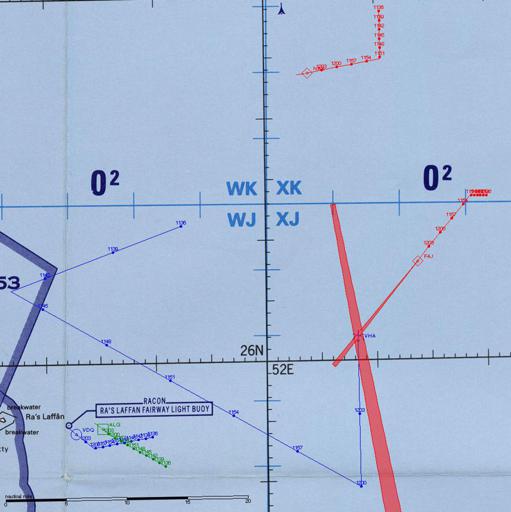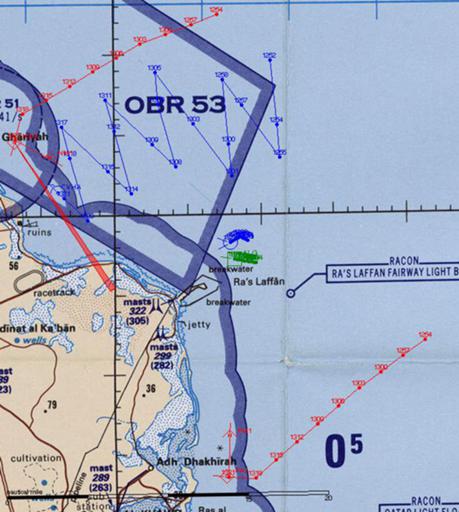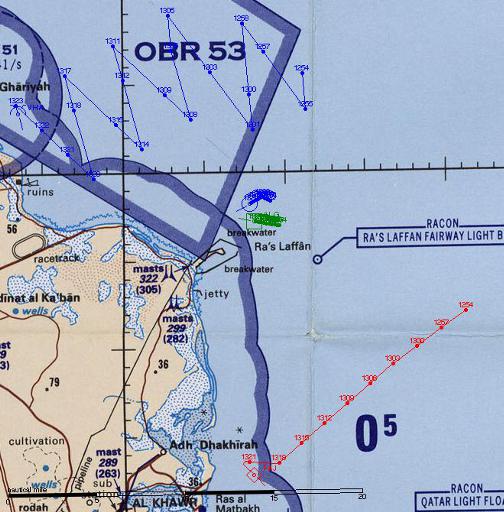Having had some interest after I posted the second AAR, I thought I'd
run a game for new players to get the hang of the way I do things
before I set up another complex scenario. But the new players didn't
apply, so I ran this one with two old hands instead. Total real time
was two weeks, including a break over Thanksgiving as one of the
players is American.
The situation was as before: a single Halifax-class frigate
escorting a tanker past two Thondor-class missile boats (since I
last ran this scenario, I've found that that's the Iranian name for
the Chinese-built Houdong). The tanker starts within the blue circle
and is aiming for the pale green one; the PTGs start in the red arcs.
(As usual, images are links to larger versions, but beware of this
first one – it's huge.)

The boats started at different spots, which made for an interesting
early situation:

When the CH-124A was searching (not all that effectively, with a
detection range against very small targets of only eleven miles
regardless of altitude), the _Thondor_s' ESM receivers were able to
pick it up and get effective cross bearings.

That didn't help them track down anything else, though, and the
helicopter (still searching) moved off to the south faster than they
could follow.

One of the attackers fired up surface-search radar, too far away to
locate either of the targets, but the helicopter was able to pick it
up. This game of blind-man's buff with occasional torch beams
continued for the next hour or so. (Note successive ESM contacts from
the helicopter, making for something like a cross-bearing from a
single platform.)

The Canadians planned to move low and fake a landing to mislead the
Iranians as to the location of their ship, but before this could be
put into practice the helo was able finally to establish radar contact
with one of the missile boats.

The helicopter moved round to approach the boat from behind for a
visual identification, and picked up the second boat to the north.
Tanker and escort slowed down and moved near the coast, hoping to take
advantage of the radar shadow of the land. Most crucially, they slowed
down.

However, the helicopter wasn't able to cover both targets at once, and
concentrated on the northern boat. The southern one was able to break
contact, shut off its radar, and move further off to the south.

Both boats moved in close to the coast (doubtless causing a diplomatic
incident with Qatar) and took their shots from further inshore than
the bigger ships could get. The frigate fired starboard Harpoons at
the northern boat, since it was still being tracked by the helicopter.
The C-802s were whittled down by Sea Sparrow, Bofors and Phalanx fire;
one hit the tanker, doing minor damage, and one made it through to
strike the frigate, with one more showering fragments across the deck
having been shot at the last moment by the Phalanx. Unfortunately, one
of those fragments was the magic bullet: it hit the portside Harpoon
launcher, still unfired, and destroyed the missiles there. Even that
would have been survivable, but the Harpoons themselves threw burning
débris into the portside VLS, detonating the remaining Sea Sparrow
missiles, and that was enough to sink the ship.
Meanwhile the Harpoons had been fired at a point in front of the
northern boat, set to turn away from shore and light up their seekers
once they got there. This worked: they tracked the PTG, and three out
of four hit, blowing it out of the water.

The Iranians knew that the Canadian radars were off the air, but the
surviving PTG was running without using his own radar, to try to hide
from return fire, and had no other information. He withdrew from the
battle; the helo had no weapons that would have been effective against
him.
So in the end that was a tactical victory for the Canadians; the
frigate was lost, but the tanker was damaged a fraction less than 10%,
and could proceed on course. The Iranians could have closed in and
taken some hours to sink the tanker with gunfire (or even forced the
crew to open the seacocks and take to the lifeboats), but they
couldn't be completely sure that the frigate wasn't still out there
hunting for them.
Thanks to Todd (Blue) and Tomasz (Red) for playing. The
moment-by-moment maps as shown to each player are
available here. Things
I've learned from running this game:
-
Well, wow. One missile really can destroy a ship that on paper
should normally be able to take the hit and keep fighting. And I'm
starting to think that engaging small missiles inside the
three-second range where they can throw fragments if shot down may
be a worse idea than simply letting them hit. (This is a bit of a
game rules effect: any weapon that does 50 or fewer damage points,
which is most of the lighter ones, does the same d6 airburst
critical hits if it's shot down with fewer than three seconds left
to run. Most of the smaller missiles would have a hard time
achieving even one critical if they hit normally.)
-
Sea-skimming missiles are very hard to spot without a 3D radar.
Having the helicopter in position meant the frigate had advance
warning of one of the missile swarms; with a second helo to shadow
the second boat it could probably have had targeting information
for, and taken down, both at a relatively safe distance. (Even so,
as with many multi-purpose ships it doesn't really have enough fire
directors to engage a swarm effectively.)
-
Having the Qatari coast in play makes a huge difference to tactics
if the commanders choose to use it, which this time they did.
Detection was harder, and setting up missile shots (particularly
with the C-802s, which don't have a waypoint capability) took a lot
of effort.
-
It would be interesting to try this with different escort ships. A
British Type 23 has the less-capable Sea Wolf rather than Sea
Sparrow and only one fire director for it, but carries a helicopter
with a better radar and anti-ship missiles of its own that are quite
capable of taking on the PTGs. An American Kidd, historically used
on this mission, is a much bigger ship, carrying long-ranged
Standard missiles with a pair of directors and two helicopters; that
would be a much tougher challenge for the Iranians. In that case one
should probably not only add more PTGs but mix in the possibility of
Iranian submarines; historically in 1996 they have two Kilos based
at Bandar Abbas, though they're under the command of the Islamic
Republic of Iran Navy rather than the Revolutionary Guards' Navy, so
one would really want a separate player.
-
Finding VSmall ships is really hard. Of the three scenarios I've
run so far, this is the only one that starts forces far enough apart
to make detection really important, and I like that about it.
Turning on your radar can be a fatal error if you do it too soon,
but doing it too late means you don't have information that you
could have used.
-
More players always welcome!
Comments on this post are now closed. If you have particular grounds for adding a late comment, comment on a more recent post quoting the URL of this one.